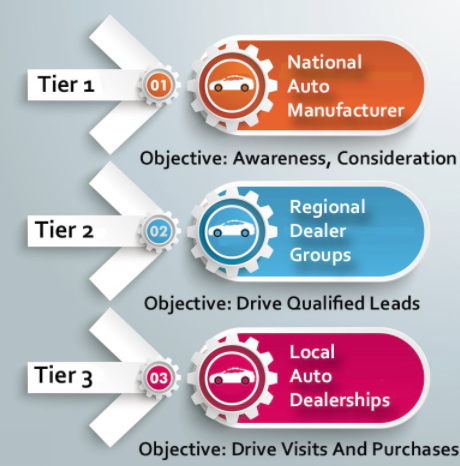
The Power of 3: Building a Cohesive Marketing Plan with Auto Co-op
If there is one number that our society as a whole is obsessed with, it would have to be the number three.
Think about it. From childhood stories featuring “The Three Little Pigs” to games that include three objects (like the ever-popular pastime of rock, paper, scissors), it always comes back to three. Even food often comes in three pieces — decadent three-layer chocolate cake, anyone?
It turns out that auto manufacturers are also partial to the number three, as their auto marketing dollars can be split into three different tiers.
More often than not, though, these three tiers fail to work together to fully utilize an auto manufacturer’s complete inventory of marketing resources.
We’re breaking down the three tiers of marketing in the auto industry and showing why it is necessary for individual dealerships to work with auto manufacturers through co-op services in order to make the most of their marketing dollars.
The 3 Tiers of Auto Marketing
Before we dig into the nitty-gritty details of each tier, here is a general overview of the three tiers of auto marketing:
- Tier 1: Why you should buy this vehicle
- Tier 2: Why you should buy this vehicle now
- Tier 3: Why you should buy this vehicle here
Image credit: Marketing Land
Now that you’re caught up with the auto marketing basics, let’s dive deeper into the wonderful (and at times complicated) three tiers of auto marketing.
Tier 1: Why?
The broadest form of auto marketing comes in tier one. This tier is all about the national brands, otherwise known as original equipment manufacturers (OEMs). Automotive OEMs include brands like Ford Motor Company, General Motors, and Fiat Chrysler.
In tier one, auto manufacturers aim to convey the general message of why you should buy this vehicle. Maybe the car advertised has excellent gas mileage compared to its competitors. Or perhaps a particular pickup truck can tow more than double its weight.
Whatever the reason, OEMs are trying to make you aware of a void in your life that can be filled only by purchasing the new vehicle they’re advertising in tier one.
As an example, we’ll use the buyer persona of Connor Carbuyer. Connor is a 35-year-old male from central Montana who loves the outdoors and is the definition of a “weekend warrior.”
Connor may be interested in purchasing a new pickup in order to better haul his four-wheeler and snowmobile across the state on his weekend adventures.
If you are Ford Motor Company, you’ll try to show Connor why the Ford F-150 is the best pickup option for him by highlighting its durable bed and strong towing ability.
In this first tier, the OEM is showcasing the vehicle itself. Tier-one advertising gives people an awareness of why and how a particular vehicle can fill a void in their lives.
Tier 2: Why Now?
The second tier of marketing for the auto industry comes down to why you should purchase this vehicle now. This message is often delivered by regional dealer groups to encourage local residents to purchase a vehicle from one of the stores in their group.
If we go back to our Connor Carbuyer example, a particular group of regional dealerships in the greater central Montana region would use tier-two advertising to convince Connor that he needs to purchase the new Ford F-150 today.
When communicating the message of why buy today, these regional dealer groups will try to show Connor the benefits of buying soon, such as a limited amount of F-150s available, a 0% APR financing special, an offer for no down payment, or any number of other reasons.
Tier 3: Why Here?
The third tier of auto marketing is all about why you should buy this vehicle here.
By now, Connor Carbuyer realizes that he needs a new Ford F-150 so that he can tow his four-wheelers across the state on his next vacation (tier one). He also realizes that now is an excellent time to buy since there are great financing offers for new Ford F-150 trucks in his area (tier two).
The next step is to show Connor Carbuyer why he needs to purchase that new Ford F-150 at a specific auto dealership.
Why might your dealership be the best place for someone to buy their next vehicle? Maybe you offer outstanding customer service, or you offer the best prices below MSRP in your area.
Whatever your advantage, tier three is the time for individual dealerships like yours to showcase what is unique about your store.
Utilizing Auto Co-op Funds for Cohesive Marketing
All three tiers of auto marketing have different priorities, but it is essential for all three tiers to work together in order to create a cohesive marketing plan that benefits both the OEM as well as the individual dealership.
To encourage the promotion, lead generation, and sales of new vehicles by individual dealerships, many OEMs have established a co-op advertising partnership between manufacturers and dealerships to share the cost of advertising.
Dealerships can get anywhere between 30% to 100% of their marketing dollars reimbursed by auto manufacturers when they follow approved co-op guidelines in their marketing of new vehicles.
The world of auto co-op has never been simple, which is why many individual dealerships choose to avoid confusion and frustration by following their own marketing plan.
In fact, one study found that last year alone, $14 billion of auto manufacturers’ allotted co-op budgets of $36 billion went unspent. That’s nearly 40% of their “free money” going unclaimed!
Choosing to forgo this “free money” can possibly save you time today — but it will hurt your dealership’s marketing in the long term. Taking the extra time to follow auto co-op guidelines will allow auto manufacturers to reimburse you for basic tier-one marketing.
With this type of auto marketing being almost 100% reimbursable, you’ll have the flexibility and room in your marketing budget to focus on tier-three marketing to spread the message of why your dealership is the place to buy.
The Future of Auto Co-op Is Digital
The amount of online activity that occurs before a vehicle purchase is astounding. In fact, 19 of the 24 touchpoints are digital. This makes digital marketing for the auto industry a no-brainer.
Auto manufacturers are realizing more and more the extra value that comes when dealerships focus their marketing efforts toward digital.
To reflect this belief in digital marketing for auto, OEMs like Ford are beginning to require that at least 50% of a dealership’s co-op budget must be spent on digital marketing.
If you haven’t hopped on the digital marketing train for auto yet, it’s not too late to join the party! 9 Clouds works with dealerships across the country on their digital marketing strategies — including the ups and downs that come with auto co-op.
Let us take your digital marketing to the next level. Schedule your free digital audit today!
schedule your digital audit





